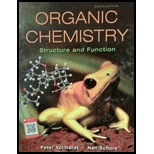
(a)
Interpretation: The mechanism and the major product formed in the reaction of a secondary
Concept Introduction: Nucleophillic substitution and elimination reactions are two types of the reactions, playing important role in
(b)
Interpretation: The mechanism and the major product formed in the reaction of a secondary haloalkane in the polar aprotic solvent needs to be determined if the nucleophile is
Concept Introduction: Nucleophillic substitution and elimination reactions are two types of the reactions, playing important role in organic chemistry. In the nucleophillic substitution reaction, a leaving group is replaced with a nucleophile and in the elimination reaction rearrangement takes place resulting formation of an alkene.
(c)
Interpretation: The mechanism and the major product formed in the reaction of a secondary haloalkane in the polar aprotic solvent needs to be determined if the nucleophile is ammonia.
Concept Introduction: Nucleophillic substitution and elimination reactions are two types of the reactions, playing important role in organic chemistry. In the nucleophillic substitution reaction, a leaving group is replaced with a nucleophile and in the elimination reaction rearrangement takes place resulting formation of an alkene.
(d)
Interpretation: The mechanism and the major product formed in the reaction of a secondary haloalkane in the polar aprotic solvent needs to be determined if the nucleophile is HSe-.
Concept Introduction: Nucleophillic substitution and elimination reactions are two types of the reactions, playing important role in organic chemistry. In the nucleophillic substitution reaction, a leaving group is replaced with a nucleophile and in the elimination reaction rearrangement takes place resulting formation of an alkene.
(e)
Interpretation: The mechanism and the major product formed in the reaction of a secondary haloalkane in the polar aprotic solvent needs to be determined if the nucleophile is fluoride ion.
Concept Introduction: Nucleophillic substitution and elimination reactions are two types of the reactions, playing important role in organic chemistry. In the nucleophillic substitution reaction, a leaving group is replaced with a nucleophile and in the elimination reaction rearrangement takes place resulting formation of an alkene.
(f)
Interpretation: The mechanism and the major product formed in the reaction of a secondary haloalkane in the polar aprotic solvent needs to be determined if the nucleophile is
Concept Introduction: Nucleophillic substitution and elimination reactions are two types of the reactions, playing important role in organic chemistry. In the nucleophillic substitution reaction, a leaving group is replaced with a nucleophile and in the elimination reaction rearrangement takes place resulting formation of an alkene.
(g)
Interpretation: The mechanism and the major product formed in the reaction of a secondary haloalkane in the polar aprotic solvent needs to be determined if the nucleophile is PH3.
Concept Introduction: Nucleophillic substitution and elimination reactions are two types of the reactions, playing important role in organic chemistry. In the nucleophillic substitution reaction, a leaving group is replaced with a nucleophile and in the elimination reaction rearrangement takes place resulting formation of an alkene.
(h)
Interpretation: The mechanism and the major product formed in the reaction of a secondary haloalkane in the polar aprotic solvent needs to be determined if the nucleophile is NH2OH.
Concept Introduction: Nucleophillic substitution and elimination reactions are two types of the reactions, playing important role in organic chemistry. In the nucleophillic substitution reaction, a leaving group is replaced with a nucleophile and in the elimination reaction rearrangement takes place resulting formation of an alkene.
(i)
Interpretation: The mechanism and the major product formed in the reaction of a secondary haloalkane in the polar aprotic solvent needs to be determined if the nucleophile is NCS-.
Concept Introduction: Nucleophillic substitution and elimination reactions are two types of the reactions, playing important role in organic chemistry. In the nucleophillic substitution reaction, a leaving group is replaced with a nucleophile and in the elimination reaction rearrangement takes place resulting formation of an alkene.
Trending nowThis is a popular solution!

Chapter 7 Solutions
EBK ORGANIC CHEMISTRY
- Basic strength of organic bases.arrow_forwardNucleophilic Aromatic Substitution: What is the product of the reaction? What is the name of the intermediate complex? *See imagearrow_forwardPredict the final product. If 2 products are made, list which should be “major” and “minor” *see attachedarrow_forward
- Nucleophilic Aromatic Substitution: What is the product of the reaction? *see imagearrow_forwardShow the correct sequence to connect the reagent to product. * see imagearrow_forwardThe answer here says that F and K have a singlet and a doublet. The singlet and doublet are referring to the H's 1 carbon away from the carbon attached to the OH. Why don't the H's two carbons away, the ones on the cyclohexane ring, cause more peaks on the signal?arrow_forward
- Draw the Birch Reduction for this aromatic compound and include electron withdrawing groups and electron donating groups. *See attachedarrow_forwardShow the correct sequence to connect the reagent to product. * see imagearrow_forwardBlocking Group are use to put 2 large sterically repulsive group ortho. Show the correct sequence toconnect the reagent to product with the highest yield possible. * see imagearrow_forward
- Elimination-Addition: What molecule was determined to be an intermediate based on a “trapping experiment”? *please solve and see imagearrow_forwardShow the correct sequence to connect the reagent to product. * see imagearrow_forwardPredict the final product. If 2 products are made, list which should be “major” and “minor”. **see attachedarrow_forward

 Organic ChemistryChemistryISBN:9781305580350Author:William H. Brown, Brent L. Iverson, Eric Anslyn, Christopher S. FootePublisher:Cengage Learning
Organic ChemistryChemistryISBN:9781305580350Author:William H. Brown, Brent L. Iverson, Eric Anslyn, Christopher S. FootePublisher:Cengage Learning

